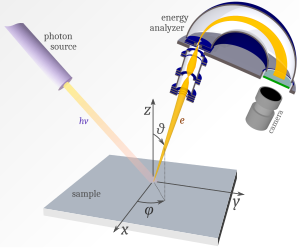
Back Fotoëlektronspektroskopie Afrikaans Фотоелектронна спектроскопия Bulgarian Fotoelektronová spektroskopie Czech Photoelektronenspektroskopie German Espectroscopia de fotoemisión Spanish Spectroscopie photoélectronique French Speictreascópacht fhótaileictreonach Irish Spettroscopia fotoelettronica Italian 光電子分光 Japanese 광전자 분광학 Korean

Photoemission spectroscopy (PES), also known as photoelectron spectroscopy,[1] refers to energy measurement of electrons emitted from solids, gases or liquids by the photoelectric effect, in order to determine the binding energies of electrons in the substance. The term refers to various techniques, depending on whether the ionization energy is provided by X-ray, XUV or UV photons. Regardless of the incident photon beam, however, all photoelectron spectroscopy revolves around the general theme of surface analysis by measuring the ejected electrons.[2]
- ^ IUPAC, Compendium of Chemical Terminology, 2nd ed. (the "Gold Book") (1997). Online corrected version: (2006–) "photoelectron spectroscopy (PES)". doi:10.1351/goldbook.P04609
- ^ Hercules, D. M.; Hercules, S.H. Al (1984). "Analytical chemistry of surfaces. Part I. General aspects". Journal of Chemical Education. 61 (5): 402. Bibcode:1984JChEd..61..402H. doi:10.1021/ed061p402.
© MMXXIII Rich X Search. We shall prevail. All rights reserved. Rich X Search